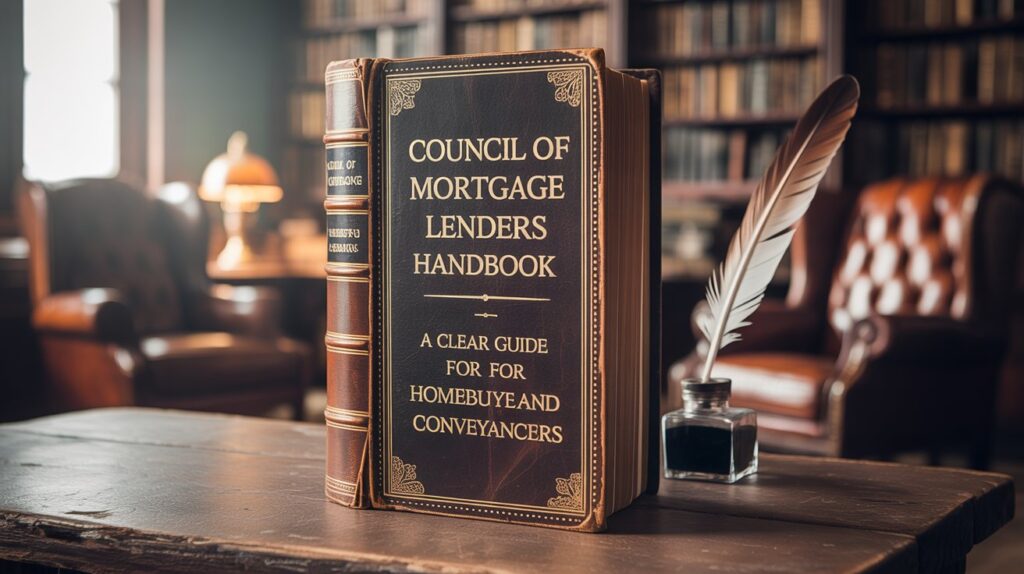Introduction to the UK Finance Mortgage Lenders’ Handbook

The mortgage process in the UK can be complex, with numerous legal and financial requirements to navigate. One critical resource for conveyancers and homebuyers alike is the UK Finance Mortgage Lenders’ Handbook, formerly known as the Council of Mortgage Lenders Handbook. This guide, issued by UK Finance, provides standardized instructions for solicitors and licensed conveyancers acting on behalf of mortgage lenders in residential property transactions. In this article, we’ll explore the significance of the Council of Mortgage Lenders Handbook, its evolution into the UK Finance framework, and key components like the Council of Mortgage Lenders form and certificate. We’ll also dive into Part 2 of the handbook, offering insights for those navigating the mortgage process, complete with a comparison table to clarify its structure.
What is the Council of Mortgage Lenders Handbook?
The Council of Mortgage Lenders Handbook was originally developed by the Council of Mortgage Lenders (CML), an industry body representing UK mortgage lenders until its merger into UK Finance in 2017. The handbook serves as a comprehensive set of instructions for conveyancers, ensuring that lenders’ interests are protected during property transactions. It outlines the legal and procedural requirements that solicitors must follow to secure a lender’s mortgage, covering everything from identity checks to insurance requirements and title certifications.
After the 2017 merger, the Council of Mortgage Lenders Handbook was rebranded as the UK Finance Mortgage Lenders’ Handbook. Despite the name change, its core purpose remains the same: to provide uniform guidance for conveyancers while allowing lenders to specify their unique requirements. The handbook is divided into multiple parts, with Part 1 offering general instructions applicable to all lenders and Part 2 detailing lender-specific requirements.
Evolution from CML to UK Finance
The Council of Mortgage Lenders was formed in 1989 and played a pivotal role in shaping the UK mortgage industry by providing research, data, and guidance. In 2017, it merged with other financial organizations to form UK Finance, a trade association representing around 300 firms across banking, finance, and mortgage sectors. This transition led to the renaming of the Council of Mortgage Lenders Handbook to the UK Finance Mortgage Lenders’ Handbook, The updated handbook upholds the same high standards, fully aligning with the requirements of the Solicitors Regulation Authority (SRA) Code of Conduct 2011 and the Council for Licensed Conveyancers (CLC) Code of Conduct 2011. It continues to evolve, with updates to address regulatory changes, such as the Mortgage Credit Directive of 2016, which introduced concepts like binding offers and reflection periods. These updates ensure the handbook remains relevant in a dynamic financial landscape.
Key Components of the Handbook
Part 1: General Instructions
Part 1 of the UK Finance Mortgage Lenders’ Handbook outlines a set of uniform guidelines followed by all participating lenders. It covers critical aspects of conveyancing, including:
- Identity Verification: Conveyancers must verify the borrower’s identity and ensure compliance with anti-money laundering regulations, such as the Proceeds of Crime Act 2002.
- Property Checks: Solicitors must confirm that the property’s purchase price aligns with the lender’s instructions and that the title is marketable.
- Insurance Requirements: The handbook mandates that properties, especially common parts of leasehold buildings, are adequately insured.
- Certificate of Title: Conveyancers must submit a Council of Mortgage Lenders certificate (now the UK Finance Certificate of Title), confirming that all conditions of the mortgage offer have been met before funds are released.
Part 2: Lender-Specific Requirements
The Council of Mortgage Lenders Handbook Part 2 (now UK Finance Handbook Part 2) allows individual lenders to outline their specific requirements, tailoring the general instructions to their policies. For example:
- Green Deal Plans: Some lenders, like Nationwide Building Society, require conveyancers to disclose details of Green Deal loans exceeding £10,000, including the balance and terms.
- Leasehold Properties: Lenders may specify minimum lease terms (e.g., mortgage term plus 25 years) or requirements for charges over freehold interests in certain leasehold scenarios.
- Building Safety: Conveyancers must report if the property owner is a non-qualifying leaseholder and provide any Landlord Certificates related to remediation works.
Part 2 is frequently updated, as lenders can modify their requirements at any time. Conveyancers must regularly check these updates to avoid costly errors, as non-compliance can lead to claims for breach of contract or professional duty.
Part 3: England and Wales
In England and Wales, the handbook includes Part 3, which provides instructions for conveyancers representing lenders but not borrowers. This section ensures clarity in scenarios where the lender’s interests are handled separately, such as in remortgage cases.
The Role of the Council of Mortgage Lenders Form and Certificate
The Council of Mortgage Lenders form and certificate are critical tools in the conveyancing process. The Certificate of Title is a formal document submitted by the conveyancer to the lender, confirming that all mortgage conditions have been satisfied, including:
- Clear search results and resolution of any title issues.
- Compliance with the lender’s instructions, such as verifying the valuation report.
- Confirmation that the property is free from undisclosed incentives or arrangements that could affect the mortgage offer.
For example, in the case of an Equity Mortgage, the handbook requires conveyancers to submit Solicitor’s Form 1 and Form 2 Undertakings alongside the Certificate of Title. These forms ensure that all conditions, such as the borrower’s cash contribution or warranty schemes like NHBC Buildmark, are met before funds are released.
Failure to adhere to these requirements can delay the mortgage process or lead to the withdrawal of the offer. Conveyancers must also provide written notice of any Equity Mortgage to the first charge lender, as outlined in the Conveyancer’s Pack.

Why the Handbook Matters for Homebuyers
For homebuyers, understanding the UK Finance Mortgage Lenders’ Handbook may seem technical, but it directly impacts the mortgage process. The handbook ensures that lenders’ interests are protected, which in turn safeguards the borrower’s ability to secure financing. Key benefits include:
- Transparency: The UK Finance Disclosure of Incentives Form ensures that any incentives offered by developers are reported, preventing hidden arrangements that could affect the mortgage.
- Protection: Requirements for new home warranties, such as NHBC Buildmark, protect buyers from structural issues in newly built properties.
- Efficiency: Standardized instructions streamline the conveyancing process, reducing delays caused by miscommunication between lenders and conveyancers.
Homebuyers should work closely with their solicitors to ensure all handbook requirements are met, especially when submitting the Certificate of Title, as this triggers the release of mortgage funds.
Comparison Table: UK Finance Handbook vs. Other Mortgage Guidelines
| Aspect | UK Finance Mortgage Lenders’ Handbook | Building Societies Association (BSA) Instructions | Individual Lender Policies |
| Scope | Applies to UK Finance member lenders | Applies to BSA member building societies | Varies by lender |
| Structure | Part 1 (general), Part 2 (lender-specific), Part 3 (England & Wales) | Similar structure, with society-specific requirements | Often standalone policies |
| Certificate of Title | Standardized, mandatory for all members | Required, but format may vary | May have unique forms |
| Updates | Frequent, especially Part 2 | Periodic updates | Varies, less standardized |
| Accessibility | Online at lendershandbook.ukfinance.org.uk | Available via BSA website | Lender-specific portals |
This table highlights the structured and standardized nature of the UK Finance Mortgage Lenders’ Handbook compared to other guidelines, making it a cornerstone of the UK mortgage industry.
Challenges and Best Practices for Conveyancers
Conveyancers face several challenges when adhering to the handbook, including:
- Frequent Updates: Part 2 changes regularly, requiring conveyancers to stay updated to avoid errors.
- Complex Requirements: Lender-specific instructions, such as those for leasehold properties or Green Deal loans, can be intricate.
- Liability Risks: Non-compliance can lead to professional negligence claims, as seen post-2008 recession.
To navigate these challenges, conveyancers should:
- Regularly check Part 2 updates on the UK Finance website.
- Maintain detailed records, as files must be retained for at least six years.
- Communicate clearly with lenders, reporting issues with recommendations rather than just flagging problems.
Conclusion
The UK Finance Mortgage Lenders’ Handbook, formerly the Council of Mortgage Lenders Handbook, is an indispensable tool for ensuring a smooth and compliant mortgage process. By providing clear instructions through Part 1, Part 2, and the Certificate of Title, it protects both lenders and borrowers while guiding conveyancers through complex transactions. Whether you’re a homebuyer or a conveyancer, understanding the handbook’s requirements—such as the Council of Mortgage Lenders form and certificate—is crucial for success in the UK property market. Stay informed, work closely with your solicitor, and leverage the handbook’s structure to secure your mortgage with confidence.
For more details, visit the UK Finance Mortgage Lenders’ Handbook or consult your conveyancer for lender-specific guidance.
FQA
Is the Council of Mortgage Lenders still active?
No, it merged into UK Finance in 2017, but the “CML Handbook” name is still commonly used.
Do all lenders follow the Handbook?
Most UK mortgage lenders do, but each can add their own rules in Part 2.
Where can I find the latest version?
The official version is published online by UK Finance and updated regularly.
Can I check my lender’s Part 2 myself?
Yes, it’s publicly available, so you can see exactly what your lender expects before you start the process.





